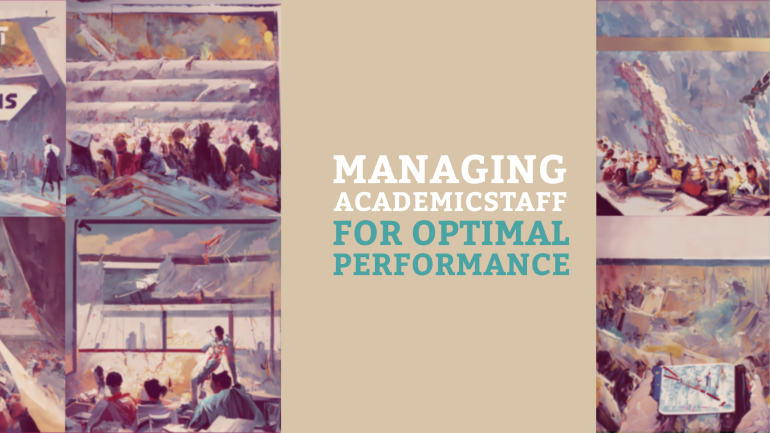Table of Contents
TL;DR: Effective Strategies for Managing Academic Staff
- Clear Communication: Ensure effective and open communication channels with academic staff to address concerns, provide feedback, and set clear expectations.
- Professional Development: Offer opportunities for ongoing training and skill development to enhance the performance and job satisfaction of academic staff.
- Recognition and Rewards: Implement a system to recognize and reward the contributions and achievements of academic staff to motivate them and improve performance.
- Performance Evaluation: Regularly evaluate the performance of academic staff against set objectives and provide constructive feedback for continuous improvement.
- Conflict Resolution: Develop strategies to address conflicts and manage interpersonal dynamics within the academic team to maintain a positive work environment.
You are responsible for ensuring that your academic staff performs at their best to drive the success of your institution. Managing academic staff effectively is crucial for achieving optimal performance and maintaining high standards of education. From motivating educators to fostering a positive work environment, there are various strategies that can help you manage academic staff for optimal performance.
Understanding the Academic Environment
Key Characteristics of Academic Institutions
Even within the diverse landscape of academic institutions, there are several key characteristics that are commonly found. These include a strong emphasis on research and scholarship, a commitment to academic freedom, a focus on critical thinking and intellectual inquiry, and a culture of collaboration and knowledge sharing.
Another important characteristic is the emphasis on independence and autonomy for both academic staff and students. This allows for the exploration of new ideas and the pursuit of knowledge without undue restrictions.
The Role of Academic Staff in Higher Education
The role of academic staff in higher education institutions is multifaceted and crucial to the success of the institution. They are responsible for not only delivering high-quality teaching and research but also for mentoring and guiding students, contributing to the academic community through publications and presentations, and participating in institutional governance.
Institutions rely heavily on the expertise and dedication of their academic staff to maintain a high standard of education and research. Ensuring that academic staff are motivated, supported, and provided with opportunities for professional development is crucial for the optimal performance of the institution.
Recruitment and Selection of Academic Staff
Defining the Ideal Candidate Profile
It is crucial to clearly define the ideal candidate profile before commencing the recruitment process for academic staff. This profile should encompass not just the technical qualifications and experience necessary for the role, but also the soft skills and attributes that align with the institution’s values and culture. A diverse range of perspectives and backgrounds can enrich the academic environment and foster innovation and collaboration.
Best Practices in Recruitment and Interviews
For achieving successful recruitment outcomes, it is crucial to adhere to best practices in both the recruitment and interview processes. This includes promoting the job opening through various channels to attract a wide pool of candidates, implementing a thorough screening process to assess qualifications and alignment with the institution’s mission, and conducting structured interviews to evaluate candidates objectively. Additionally, providing timely feedback to all applicants and ensuring transparency and fairness throughout the selection process are key elements of best practices in recruitment.
The interview stage is a critical opportunity to not only evaluate the candidates’ qualifications but also to assess their fit within the department and institution culture. Having a diverse panel of interviewers can offer multiple perspectives and reduce bias, ultimately leading to a more comprehensive evaluation of the candidates. It is imperative to ask insightful questions that probe beyond just technical competencies to gauge the candidates’ problem-solving abilities, interpersonal skills, and alignment with the institution’s values.
Professional Development and Training
Designing Impactful Training Programs
Not all training programs are created equal when it comes to developing academic staff. It is crucial to design and implement impactful training programs that are tailored to the specific needs and goals of the individuals and the institution. One-size-fits-all approaches are not effective when aiming to optimize staff performance.
Mentoring and Continuous Learning Opportunities
Training is just the beginning when it comes to professional development. Providing mentoring and continuous learning opportunities is necessary for academic staff to continuously grow and excel in their roles. These opportunities can include access to conferences, workshops, online courses, and collaborative projects with colleagues.
Mentoring and continuous learning opportunities help staff stay current with the latest advancements in their field, develop new skills, and stay motivated in their roles. By fostering a culture of learning and growth, academic institutions can ensure that their staff perform at their best and contribute effectively to the overall success of the institution.
Performance Evaluation and Feedback
Developing a Fair and Comprehensive Evaluation System
Fair and comprehensive performance evaluations are vital for managing academic staff effectively. To develop a system that ensures fairness and accuracy, it is important to establish clear evaluation criteria that are aligned with the academic staff’s roles and responsibilities. This criteria should be transparent, measurable, and specific to provide a clear understanding of expectations. Additionally, involving academic staff in the evaluation process by allowing self-assessments and feedback can help in providing a well-rounded evaluation.
Methods of Providing Constructive Feedback
Systematic and constructive feedback is crucial for the growth and development of academic staff. Regular feedback sessions should be conducted to provide timely and specific information on performance. Feedback should focus on observations and examples of behavior or actions, rather than personal attributes, to encourage improvement. Additionally, feedback should be constructive, offering actionable suggestions for enhancement and areas for development.
Understanding the importance of performance evaluation and feedback mechanisms is critical in managing academic staff for optimal performance. By developing a fair evaluation system and implementing effective feedback methods, academic institutions can support the continuous growth and improvement of their staff, ultimately enhancing the quality of education and research.
Motivation and Job Satisfaction
Once again, when it comes to managing academic staff for optimal performance, understanding motivation and job satisfaction is crucial. Motivated and satisfied staff are more productive, engaged, and likely to stay with the organization for the long term.
Incentives and Reward Systems
With the right incentives and reward systems in place, academic staff can be motivated to perform at their best. Recognition of achievements, opportunities for career advancement, and fair financial compensation are all factors that can contribute to job satisfaction. It is vital to tailor these incentives to the individual preferences and motivations of each staff member to ensure effectiveness.
Work-Life Balance and Job Satisfaction
An optimal work-life balance is vital for job satisfaction among academic staff. Balancing heavy workloads, research commitments, and administrative responsibilities can be challenging. Implementing policies that support flexibility, providing adequate resources, and encouraging self-care can help staff maintain a healthy balance between work and personal life.
This balance is crucial for preventing burnout and improving overall job satisfaction. Staff who feel supported in managing their work and personal commitments are likely to be more engaged, motivated, and productive in their roles.
Leadership and Management Styles in Academia
All academic institutions, whether universities or research centers, depend heavily on the leadership and management styles of their academic staff to function effectively. Leadership in academia is a multifaceted concept that requires a deep understanding of not only theoretical knowledge but also practical application. Various leadership theories and practices have been identified as suitable for academic settings, each with its strengths and limitations.
Leadership Theories and Practices Suitable for Academic Settings
Leadership in academia often involves a mix of transformational, transactional, and servant leadership styles. Transformational leadership can inspire and motivate academic staff towards a common vision, while transactional leadership ensures goals are achieved through a system of rewards and punishments. Servant leadership emphasizes the leader’s role as a servant to others, fostering a culture of collaboration and support within academic teams.
Emotional Intelligence and Its Role in Staff Management
Emotional intelligence plays a crucial role in staff management within academic institutions. Leaders with high emotional intelligence can navigate complex interpersonal relationships and resolve conflicts effectively. They are better equipped to understand and respond to the emotions of their team members, creating a more positive and productive work environment.
With the rise of emotional intelligence as a key factor in successful leadership, academic institutions are increasingly prioritizing the development of emotional intelligence skills among their academic staff. Leaders who possess strong emotional intelligence are better equipped to handle the pressures and challenges of academic environments, leading to improved staff performance and job satisfaction.
Conflict Resolution and Mediation
For academic institutions, conflict among staff members can be detrimental to productivity and team morale. Conflict resolution and mediation strategies play a crucial role in maintaining a healthy work environment. It is important for academic administrators to be adept at handling conflicts and facilitating resolutions to ensure optimal performance from the staff.
Techniques for Handling Disputes Among Academic Staff
Conflict among academic staff can arise due to various reasons such as differences in opinions, miscommunication, or conflicting work styles. When addressing disputes, it is important to listen to all parties involved and understand their perspectives. Mediation sessions can be organized to allow staff members to express their concerns in a structured setting. Encouraging open communication and promoting empathy can help in finding common ground and resolving conflicts effectively.
Creating a Collegial and Collaborative Work Environment
To foster a collegial and collaborative work environment, academic institutions can implement initiatives that promote teamwork and mutual respect among staff members. Encouraging interdisciplinary collaborations and team-building activities can strengthen relationships and create a sense of unity within the academic community. Recognizing and appreciating the diverse skills and contributions of staff members can further enhance a supportive work culture.
Work environments that prioritize collaboration and collegiality tend to have higher levels of job satisfaction and employee engagement. By fostering a sense of camaraderie and teamwork, academic staff are more likely to work cohesively towards common goals and objectives. Creating opportunities for professional development and collaboration can also lead to innovation and academic excellence within the institution.
Summing up
In managing academic staff for optimal performance, it is crucial to establish clear expectations, provide ongoing support and feedback, and foster a culture of continuous professional development. By recognizing the unique needs and motivations of each staff member, academic leaders can create a positive work environment that promotes high performance and productivity. Effective communication, collaboration, and recognition of achievements are key elements in maximizing the potential of academic staff members.
By implementing strategies that address the challenges and opportunities in the academic setting, institutions can cultivate a highly engaged and motivated workforce. Investing in the development of academic staff not only benefits the individuals themselves but also enhances the overall success and reputation of the institution. With a proactive approach to managing academic staff, institutions can ensure that their employees are empowered to excel in their roles and contribute to the achievement of organizational goals.
FAQ
Q: Why is managing academic staff for optimal performance important?
A: Managing academic staff for optimal performance is crucial as it ensures that the educational institution operates efficiently, maintains high standards of teaching and research, and ultimately enhances the overall academic reputation.
Q: What are the key strategies for managing academic staff effectively?
A: Key strategies for managing academic staff effectively include setting clear expectations, providing regular feedback and support, fostering a culture of collaboration, recognizing and rewarding performance, and promoting professional development.
Q: How can academic leaders motivate their staff to achieve optimal performance?
A: Academic leaders can motivate their staff by establishing a shared vision and goals, involving them in decision-making processes, offering opportunities for growth and advancement, and creating a positive work environment that values their contributions.
Q: What are some common challenges in managing academic staff for optimal performance?
A: Common challenges in managing academic staff for optimal performance include navigating complex power dynamics, addressing resistance to change, balancing teaching and research responsibilities, managing workloads effectively, and addressing conflicts within the team.
Q: How can academic institutions benefit from effectively managing their staff for optimal performance?
A: Academic institutions can benefit from effectively managing their staff for optimal performance by improving student outcomes, enhancing research productivity, attracting and retaining top talent, fostering a culture of innovation, and maintaining a competitive edge in the academic landscape.




